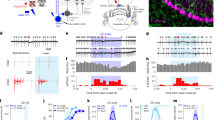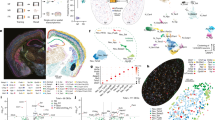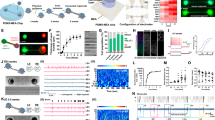Abstract
Feeding behavior is governed by homeostatic needs and motivational drive to obtain palatable foods. Here, we identify a population of glutamatergic neurons in the paraventricular thalamus of mice that express the glucose transporter Glut2 (encoded by Slc2a2) and project to the nucleus accumbens. These neurons are activated by hypoglycemia and, in freely moving mice, their activation by optogenetics or Slc2a2 inactivation increases motivated sucrose-seeking but not saccharin-seeking behavior. These neurons may control sugar overconsumption in obesity and diabetes.
This is a preview of subscription content, access via your institution
Access options
Subscribe to this journal
Receive 12 print issues and online access
$209.00 per year
only $17.42 per issue
Buy this article
- Purchase on Springer Link
- Instant access to full article PDF
Prices may be subject to local taxes which are calculated during checkout



Similar content being viewed by others
References
Unger, R.H. & Orci, L. N. Engl. J. Med. 304, 1518–1524 (1981).
Berridge, K.C., Robinson, T.E. & Aldridge, J.W. Curr. Opin. Pharmacol. 9, 65–73 (2009).
Volkow, N.D., Wang, G.J., Tomasi, D. & Baler, R.D. Biol. Psychiatry 73, 811–818 (2013).
Sclafani, A. & Ackroff, K. Physiol. Behav. 79, 663–670 (2003).
Levine, A.S., Kotz, C.M. & Gosnell, B.A. Am. J. Clin. Nutr. 78, 834S–842S (2003).
Norgren, R., Hajnal, A. & Mungarndee, S.S. Physiol. Behav. 89, 531–535 (2006).
Sclafani, A. Physiol. Behav. 89, 525–530 (2006).
Sclafani, A. Physiol. Behav. 87, 734–744 (2006).
Smith, G.P. Appetite 43, 11–13 (2004).
Hajnal, A., Smith, G.P. & Norgren, R. Am. J. Physiol. Regul. Integr. Comp. Physiol. 286, R31–R37 (2004).
Salamone, J.D. & Correa, M. Neuron 76, 470–485 (2012).
Tarussio, D. et al. J. Clin. Invest. 124, 413–424 (2014).
Gale, J.T., Shields, D.C., Ishizawa, Y. & Eskandar, E.N. Front. Behav. Neurosci. 8, 114 (2014).
Corbit, L.H. & Balleine, B.W. J. Neurosci. 31, 11786–11794 (2011).
Lamy, C.M. et al. Cell Metab. 19, 527–538 (2014).
Mounien, L. et al. FASEB J. 24, 1747–1758 (2010).
Arbeláez, A.M. et al. Diabetes Care 35, 2570–2574 (2012).
Eny, K.M., Wolever, T.M., Fontaine-Bisson, B. & El-Sohemy, A. Physiol. Genomics 33, 355–360 (2008).
Laukkanen, O. et al. Diabetes 54, 2256–2260 (2005).
Richardson, N.R. & Roberts, D.C. J. Neurosci. Methods 66, 1–11 (1996).
Seyer, P. et al. J. Clin. Invest. 123, 1662–1676 (2013).
Acknowledgements
The authors would like to thank C. Magnan for help with preliminary feeding experiments. This work was supported by a grant from the Swiss National Science Foundation (3100A0B-128657) and a European Research Council advanced grant (INSIGHT), both to B.T.
Author information
Authors and Affiliations
Contributions
B.T., G.L. and B.B. designed the experimental strategy and analyzed the data. D.T. performed histological analysis and supervised mouse breeding. All other experiments were performed by G.L. B.T. and G.L. wrote the manuscript. All authors commented on the manuscript.
Corresponding author
Ethics declarations
Competing interests
The authors declare no competing financial interests.
Integrated supplementary information
Supplementary Figure 1 Inactivation of Slc2a2 enhances motivated sucrose-seeking behavior.
a, Acquisition curves showing mean nosepokes performed on inactive port under FR1 schedule with sucrose 10 % as a reward in control (grey circles, n = 22) versus NG2KO (white circles, n = 18) mice. Both genotypes exhibited similar performance (genotype effect, F(1,341) = 0.74, P>0.05; interaction, F(9,341) = 0.81, P>0,05; two-way ANOVA followed by Bonferroni’s test). b, Similar as a with saccharin 0.2 % as a reward (genotype effect, F(1,341) = 1.87, P>0.05; interaction, F(9,341) = 0.42, P>0,05; two-way ANOVA followed by Bonferroni’s test). Graphs show means ± s.e.m.. n.s.: non significant.
Supplementary Figure 2 Glut2-positive fibers in NAc and CTxB injection.
a, Visualization of Glut2 positive fibers (tdtomato, red fluorescence) in the NAc of a Slc2a2-cre;Rosa26tdtomato mouse. Scale bar represents 100 μm. b, Stereomicroscopic view of coronal NAc-containing brain slice showing CTxB injection sites (green fluorescence). Scale bar represents 500 μm. Nucleus accumbens core (AcbC), shell (AcbSh), lateral ventricule (LV) and anterior commissure (aca).
Supplementary Figure 3 Glucose-sensing by PVT Glut2 neurons is cell autonomous and insensitive to fructose.
a, Mean firing frequency monitored under the indicated extracellular glucose concentrations from PVT Glut2-expressing neurons in the presence of a cocktail of synaptic blockers (n = 10 neurons in 7 mice). Hypoglycemia induced a significant increase of the firing rate (P<0.05, one-way ANOVA followed by a Bonferroni’s test). b, Mean firing frequency monitored under the indicated extracellular glucose concentrations from PVT Glut2-expressing neurons in the presence or the absence of fructose (Fru) (n = 10 neurons in 6 mice). The presence of extracellular fructose did not affect Glut2 neurons firing rate (P>0.05; one-way ANOVA followed by a Bonferroni’s test). c, Mean firing frequency monitored under the indicated extracellular glucose concentrations from PVT Glut2-negative neurons (n = 12 neurons in 8 mice). Note that Glut2-negative cells were unresponsive to hypoglycemia (P>0.05, one-way ANOVA followed by a Bonferroni’s test). Boxplots show median, lower and upper quartiles (box), and minimum and maximum (whiskers). * P<0.05; n.s.: non significant.
Supplementary Figure 4 In vivo optogenetic activation of PVT Glut2 neurons.
a, Acquisition curves showing mean nosepokes performed on inactive port during FR1 operant conditioning for sucrose coupled with in vivo light stimulation of PVT Glut2 neurons in control (grey circles, n = 13) or Slc2a2-cre mice (white circles, n = 15) who received prior PVT injection of AAV-DIO-ChR2. Blue rectangles indicate light pulses (473 nm, 10 ms light pulses at 20 Hz, 1 s on/1s off). Light-evoked neuronal activation transiently increased number of inactive nosepokes performed in Slc2a2-cre mice on day 3 (genotype effect, F(1,182) = 18.49, P<0.001; interaction, F (6,182) = 2.57, P<0,05; two-way ANOVA followed by Bonferroni’s test). b, Mean reward (sucrose 10 %) and c, breakpoint value monitored under progressive ratio tested one month later without light stimulation in the same mice used in fig. 3h–k. Note that light pulses no longer increased motivation for sucrose seeking (P>0.05, t-test). Graphs show means ± s.e.m; Boxplots show median, lower and upper quartiles (box), and minimum and maximum (whiskers). The levels of significance are: *** P<0.001; n.s.: non significant. Paraventricular thalamic nucleus (PVT) and nucleus accumbens (NAc).
Supplementary Figure 5 In vivo optogenetic activation of NAc-projecting Glut2 neurons increases sucrose-seeking behavior.
a, Schematic of the experimental approach. ChR2 was virally delivered in PVT of Slc2a2-cre or control mice and fiber-optic cannulas were bilaterally implanted in the NAc, b,c, FR1 operant conditioning for sucrose 10% coupled with in vivo light stimulation of Glut2 terminals in NAc in control (grey circles, n = 8) or Slc2a2-cre mice (white circles, n = 10) which received prior PVT injection of AAV-DIO-ChR2. Blue rectangles indicate light pulses (473 nm, 10 ms light pulses at 20 Hz, 1 s on/1s off). Light-evoked neuronal activation increased operant responses to obtain sucrose (Reward: genotype effect, F(1,128) = 14.63, P<0.001; interaction, F(7,128) = 1.63, P = 0.1336; Active nosepokes: genotype effect, F(1,128) = 23.60, P<0.001; interaction, F (7,128) = 1.76, P = 0.0999; two-way ANOVA followed by Bonferroni’s test). d, Mean sucrose reward and e, breakpoint value monitored under progressive ratio schedule with in vivo light stimulation of Glut2 terminals in control (grey boxes) or Slc2a2-cre mice (white boxes)(P<0.01; unpaired t-test). f,g, Mean sucrose reward and breakpoint value monitored under progressive ratio 3 days later without light stimulation (same mice as those used in panels d and e). Note that in the absence of light stimulation no longer increased in motivation for sucrose is observed (P>0.05, unpaired t-test). h, Acquisition curves showing mean nosepokes performed on inactive port during FR1 operant conditioning for sucrose coupled with in vivo light stimulation of Glut2 PVT neurons in control (grey circles) or Slc2a2-cre mice (white circles) who received prior PVT injection of AAV-DIO-ChR2. Blue rectangles indicate light pulses (473 nm, 10 ms light pulses at 20 Hz, 1 s on/1s off). Graphs show means ± s.e.m; Boxplots show median, lower and upper quartiles (box), and minimum and maximum (whiskers). The levels of significance are: *** P<0.001; ** P<0.01; n.s.: non significant.
Supplementary Figure 6 Inactivation of Slc2a2loxP in PVT by stereotactic injection of AAV-Cre-GFP.
a, PCR analysis of genomic DNA revealed the presence of the Slc2a2loxP allele (281 bp) and of the recombined Slc2a2Δ allele (326 bp) in dissected PVT from the injected mice. b, Fluorescence micrograph showing GFP expression in the PVT of mice after stereotactic injection of AAV-Cre-GFP in the PVT. Scale bar represents 100 μm. c, Full-size picture of the original PCR amplification product separation gel. Paraventricular thalamic nucleus (PVT) and third ventricule (3V).
Supplementary information
Supplementary Text and Figures
Supplementary Figures 1–6 (PDF 1148 kb)
Rights and permissions
About this article
Cite this article
Labouèbe, G., Boutrel, B., Tarussio, D. et al. Glucose-responsive neurons of the paraventricular thalamus control sucrose-seeking behavior. Nat Neurosci 19, 999–1002 (2016). https://doi.org/10.1038/nn.4331
Received:
Accepted:
Published:
Issue Date:
DOI: https://doi.org/10.1038/nn.4331
This article is cited by
-
Spectro-spatial features in distributed human intracranial activity proactively encode peripheral metabolic activity
Nature Communications (2023)
-
A quadruple dissociation of reward-related behaviour in mice across excitatory inputs to the nucleus accumbens shell
Communications Biology (2023)
-
A paraventricular thalamus to insular cortex glutamatergic projection gates “emotional” stress-induced binge eating in females
Neuropsychopharmacology (2023)
-
Neuropeptides Modulate Feeding via the Dopamine Reward Pathway
Neurochemical Research (2023)
-
Thalamic subnetworks as units of function
Nature Neuroscience (2022)



